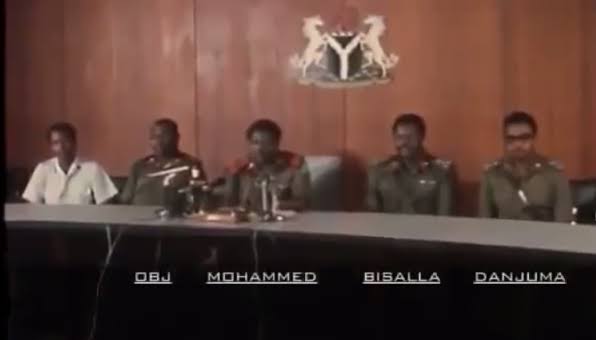News
How Obasanjo, TY Danjuma Rejected Offer To Succeed Murtala Muhammed – IBB

Former Military President, General Ibrahim Badamasi Babangida (IBB), has revealed that former President Olusegun Obasanjo initially declined to succeed General Murtala Muhammed as Head of State following the failed 1976 coup. Instead, Obasanjo considered retiring from the Army before eventually accepting the role under pressure from senior military officers.
In his autobiography, A Journey in Service, Babangida provided fresh insights into the power struggle that followed the February 13, 1976, coup attempt led by Lieutenant-Colonel Bukar Dimka, which resulted in the assassination of Murtala Muhammed.
Danjuma Endorsed Obasanjo Amid Leadership Uncertainty
Babangida recounted that the Supreme Military Council (SMC) convened the next day in Lagos to select a new leader. The discussions revolved around two senior officers—Lieutenant-General Theophilus Danjuma and Lieutenant-General Olusegun Obasanjo. Initially, the preference leaned towards Danjuma, but he refused, insisting that Obasanjo, as Murtala’s deputy, should assume the position.
“The next day, the SMC met in Lagos to pick a successor to General Muhammed. We knew it would be either General Obasanjo or General Danjuma since, as Lieutenant-Generals, they were the most senior. As I recall, the pendulum swung in favour of General Danjuma at the start of the deliberations. Everyone present, including Obasanjo, thought Danjuma should take over.
“But somehow, Danjuma cast his lot with Obasanjo, insisting that as Muhammed’s deputy and a ‘senior’ Lieutenant-General, Obasanjo should succeed Murtala Muhammed. Obasanjo refused and offered, if I recall accurately, to retire from the Army to enable Danjuma to emerge as Head of State. There appeared to be a momentary stalemate. But that soon faded away. Faced with the insistence of Danjuma, everyone caved in, and Obasanjo accepted the challenge to succeed Murtala,” Babangida wrote.

How the Coup Was Crushed: Babangida’s Account
Beyond the leadership succession, Babangida detailed his role in suppressing Dimka’s coup attempt. He described how he was dispatched to the Radio House to disarm the mutineers and ultimately neutralize their operations.
“Meanwhile, I returned to General Danjuma to give him a report of my encounter with Dimka. Danjuma was furious. He ordered me back to the Radio House with a reiteration of his earlier instructions to ‘flush Dimka out of place immediately.’
“I returned to the Radio House with Chris Ugokwe, better equipped and prepared. By now, we had been joined by, among others, Mike Otuwa, James Ojokojo, John Shagaya, and Jack Iketubosin.
Recommended News:
- SYA Joins Akarigbo, Umahi, Abiodun Other Stakeholders At Official Flag-Off Reconstruction Of Sagamu-Benin Expressway
- Akarigbo, Area Commander Intervene In Sagamu’s Power Crisis, Urges Urgent Meeting Between Sagamu Youth Association, IBEDC
- Adron Homes Celebrates 13 Years Of Transforming Nigeria’s Real Estate Landscape
“But first, I had to reach out to my friend and classmate, Sani Sami, who commanded the Brigade of Guards, to handle a difficult assignment. The Brigade of Guards’ barracks provided easy access to the Radio House. But again, I had to be careful since I wasn’t sure whether the Brigade was still loyal to the government.
“Sani Sami and I consulted and agreed that there should be minimum destruction. And that we would do what we were taught as cadets in situations involving a civilian population to ensure that civilians got out of the way and didn’t get injured.”
Babangida narrated how his team moved in, cordoned off the area, and engaged in a gun battle with the mutineers. Several plotters were either arrested or killed, though Dimka managed to escape.
National Mourning and Military Reaffirmation
Following Murtala’s assassination, a seven-day national mourning period was declared. His funeral, held on February 14, 1976, in Kano, witnessed an outpouring of grief, with mass protests erupting across the country.
Labour unions, civil society groups, and students expressed their solidarity with the fallen leader, reinforcing the national sentiment against the coup plotters. Meanwhile, the military, under Major-General Alani Akinrinade of the 1st Division in Kaduna, quickly reaffirmed its loyalty to Murtala’s administration, effectively shutting down any further attempts to destabilize the government
Legacy of the 1976 Coup and Obasanjo’s Leadership
Obasanjo’s eventual acceptance of leadership paved the way for Nigeria’s first transition to civilian rule in 1979. His government, despite initial hesitations, laid the groundwork for democratic governance, handing over power to President Shehu Shagari.
Babangida’s revelations offer a gripping account of the internal political dynamics within the Nigerian military at a critical moment in the nation’s history. His firsthand testimony sheds light on the sacrifices and decisions that shaped the country’s leadership trajectory.
As Nigerians continue to reflect on past leadership transitions, these insights serve as a crucial reminder of the volatility and resilience of the nation’s political landscape.
For the latest updates on historical revelations and national politics, stay tuned to Eaglesforesight News Hub












